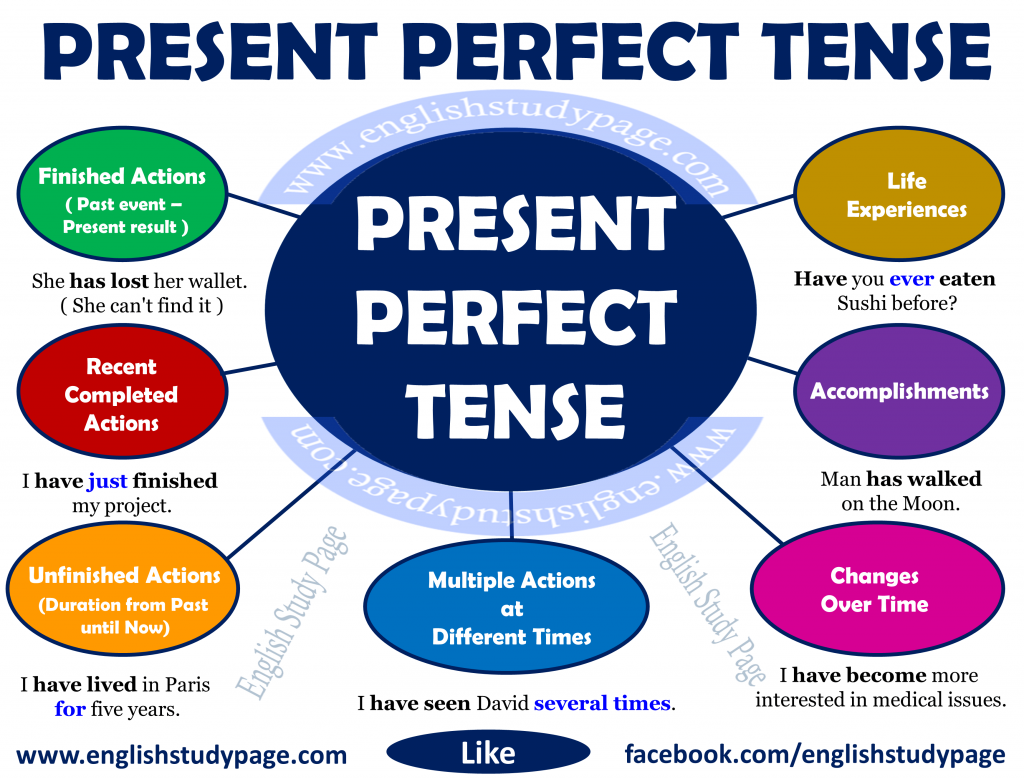The Present Perfect is a rather important tense in English, but it gives speakers of some languages a difficult time. That is because it uses concepts or ideas that do not exist in those languages. In fact, the structure of the Present Perfect is very simple. The problems come with the use of the tense. In addition, there are some differences in usage between British and American English.
In this lesson we look at the structure and use of the Present Perfect tense, as well as the use of for and since, followed by a quiz to check your understanding.
Table of Contents
What is Present Perfect?
The Present Perfect is used to express past actions that are connected to the present. The time of the action is not important. What is important is that the action is complete, and its results or effects are still present in the present.
For example:
- I have read the book. This means that I read it at some time in the past, and I still have it with me now, or I can still remember what happened in it.
- They have gone out. This means that they left at some point in the past, and they are not here now.
Importance of Present Perfect Tense in English Grammar
The Present Perfect is a very important tense in English, and unfortunately it is often misunderstood by non-native speakers. This is because the Present Perfect is used in several different ways, and these can be confusing for people who are not used to thinking about time in this way.
In addition, the Present Perfect is often used with words and expressions that refer to time, such as ever, never, already, yet, so far, up to now, recently, lately, and in the past few days. These can also be confusing for people who are not used to thinking about time in this way.
The Present Perfect is used:
- To talk about past actions that have resulted in the present.
- To talk about past actions that happened at an unspecified time.
- To talk about how many times something has happened.
- To talk about past actions that began in the past and continue in the present.
The Structure of the Present Perfect
The subject + have/has + the past participle of the verb
The Present Perfect is made up of two parts: the subject and the past participle of the verb. The past participle is usually the same as the regular past tense form of the verb, but there are some irregular verbs in English that have a different past participle.
Here are some examples of Present Perfect sentences:
– I have eaten lunch.
– They have gone out.
– We have seen that movie many times.
– Have you ever ridden a camel?
For and Since with Present Perfect tense
The Present Perfect can be used with for and since to talk about actions that began in the past and continue up to the present.
For example:
- I have lived in New York for 10 years. (I still live there.)
- He has worked at that company since 2009. (He still works there.)
We can also use the Present Perfect with for and since to talk about actions that happened at an unspecified time in the past.
For example:
- I have seen that movie. (I saw it at some point in the past, but I don’t remember when.)
- They have eaten lunch. (They ate at some point in the past, but I don’t know when.)
- We have read that book. (We read it at some point in the past, but I don’t know when.)
Take a Quiz: Present Perfect Tense
Test your knowledge of the Present Perfect tense with this quiz. Choose the correct answer for each question.
- I __________ my keys.
- has lost
- have lost
- They __________ to the party yet.
- hasn’t gone
- haven’t gone
- We __________ the reports.
- hasn’t read
- haven’t read
- Have you __________ her yet?
- saw
- seen
- I __________ tennis for two hours.
- played
- has played
Contraction with Present Perfect:
I have = I’ve
You have = You’ve
He has = He’s
She has = She’s
It has = It’s
We have = We’ve
They have = They’ve
Present Perfect Negative:
To make a Present Perfect sentence negative, we add not after have/has.
For example:
- I have not seen that movie.
- They have not gone out yet.
- We have not read the reports.
- He has not arrived yet.
FAQs:
Question-1: How do we make the Present Perfect tense?
Answer: The Present Perfect is made up of two parts: the subject + have/has + the past participle of the verb.
Question-2: What is the past participle?
Answer: The past participle is usually the same as the regular past tense form of the verb, but there are some irregular verbs in English that have a different past participle.
Question-3: Can we use Present Perfect with for and since?
Answer: Yes, we can use Present Perfect with for and since to talk about actions that began in the past and continue up to the present, or actions that happened at an unspecified time in the past.
Question-4: Can we make Present Perfect sentences negative?
Answer: Yes, to make a Present Perfect sentence negative, we add not after have/has.
Question-5: Can we use contractions with Present Perfect?
Answer: Yes, we can use contractions with Present Perfect: I have = I’ve, You have=You’ve
Conclusion:
Present Perfect tense is used to describe an event that happened in the past and its effects are still felt in the present. It is often used to talk about experiences, past habits, and recent events. The present perfect tense is a very important tense to know in English and it is often used in daily conversation. AmazingTalker is an Online learning platform who has 100+ professional tutors to teach English grammar correctly. We hope that this blog post will help students understand the importance of learning this important tense.
The Present Perfect is a very important tense in English, and unfortunately it is often misunderstood by non-native speakers. This is because the Present Perfect is used in several different ways, and these can be confusing for people who are not used to thinking about time in this way.











